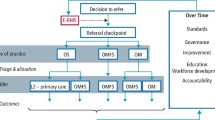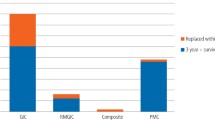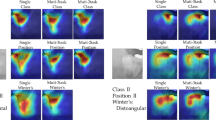Abstract
Aim To evaluate the accuracy, sensitivity and specificity of three primary to secondary care referral strategies.
Method Thirty two primary care dental practitioners (GDPs) were randomly allocated one of three referral strategies: current practice (control strategy); a neural network embedded within a computer program and a paper-based clinical algorithm. One hundred and seven patients were assessed for lower third molar treatment: 47, 30 and 30 in each group, respectively. Clinical details were assessed by a panel of experts against a gold standard for third molar removal (the National Institutes of Health criteria). The accuracy, sensitivity, specificity, positive and negative predictive values were calculated for each strategy.
Results The referral decisions made by the GDPs in the control group displayed greater accuracy and sensitivity but poorer specificity (0.83; 0.97; 0.22) compared with the neural network (0.67; 0.56; 0.79) and clinical algorithm (0.73; 0.56; 0.93).
Conclusions It was concluded that incorporation of the clinical algorithm into primary care was the most appropriate option. The computer neural network performed less well than either current practice or the clinical algorithm.
Similar content being viewed by others
Log in or create a free account to read this content
Gain free access to this article, as well as selected content from this journal and more on nature.com
or
References
Guralnick W C, Laskin D M . NIH consensus development conference for removal of third molars. J Oral Surg 1980; 38: 235–236.
Tulloch J F C, Antczak-Boukoms A . Decision analysis in the evaluation of clinical strategies for the management of mandibular third molars. J Dent Ed 1987; 51: 652–660.
Brickley M R, Kay E Shepherd J P, Armstrong R A . Decision Analysis for Lower-third-molar Surgery. Med Dec Mak 1995; 15: 143–151.
Edwards M J, Brickley M R Goodey R D, Shepherd J P . The cost, effectiveness and cost effectiveness of removal and retention of asymptomatic, disease free third molars. Br Dent J 1999; 187: 380–384.
National Institute of Clinical Excellence. Guidance on the removal of Wisdom Teeth. London: NICE, 2000.
Yablon P, Wolf M C Maykow K P . Third Molar Teeth: Differing Concepts of Oral Surgeons and Other Dentists. New York State J 1988; 54: 27–31.
Knutsson K, Brehmer B Lysell L, Rohlin M . General dental practitioners' evaluation of the need for the extraction of asymptomatic mandibular third molars. Community Dent Oral Epidemiol 1992; 20: 347–350.
Lysell L, Brehmer B Knutsson K, Rohlin M . Judgement on removal of asymptomatic mandibular third molars: influence of the perceived likelihood of pathology. Dent Max Radiol 1993; 22: 173–177.
Joynson O B, Williams S L Brickley M R, Shepherd J P . Lower third molar treatment planning ability of general dental practitioners and oral oral maxillofacial surgeons using receiver operating characteristics methodology. Brit Dent J 1996; 181: 411–415.
Knutsson K, Brehmer B Lysell L, Rohlin M . Judgement of removal of asymptomatic mandibular third molars: influence of position, degree of impaction, and patient's age. Acta Odontol Scand 1996; 54: 348–354.
Kostopoulou O, Brickley M R, Shepherd J P, Knutsson K, Rohlin M . Agreement between practitioners concerning removal of asymptomatic third molars. Community Dent Health 1997; 14: 129–132.
Jones C M, O'Brien K Blinkhorn A S, Rood J P . Dentists' agreement on treatment of asymptomatic impacted third molar teeth. Br Med J 1998; 315: 1204.
Kostopoulou O, Brickley M R, Shepherd J P, Newcombe R G, Knutsson K, Rohlin M . Intra-observer reliability regarding removal of asymptomatic third molars. Br Dent J 1998; 184: 557–558.
Worrall S F, Riden K Haskell R, Corrigan A M . UK National Third Molar project: the initial report. Br J Oral Maxillofac Surg 1998; 36: 14–18.
Brickley M R, Shepherd J P . Performance of a Neural Network Trained to Make Third-Molar Treatment-Planning Decisions. Med Dec Mak 1996; 16: 153–160.
Kugelberg C F . Third molar surgery. Curr Opin Dent 1992; 2: 9–16.
Edwards M J . A decision analysis to assess the cost, effectiveness and cost-effectiveness of surgical removal and non surgical treatment in the management of mandibular third molars. MPhil. U. Of Wales, 1998.
Renton T, McGurk M . Direct referral daycase oral surgery for dental practitioners: a pilot investigation. Br Dent J 1999; 186: 334–337.
Acknowledgements
We are grateful to all the dental practitioners who took part in this study and to the PPP Medical Trust for project funding.
Author information
Authors and Affiliations
Additional information
Refereed paper
Rights and permissions
About this article
Cite this article
Goodey, R., Brickley, M., Hill, C. et al. A controlled trial of three referral methods for patients with third molars.. Br Dent J 189, 556–560 (2000). https://doi.org/10.1038/sj.bdj.4800828
Received:
Accepted:
Published:
Issue date:
DOI: https://doi.org/10.1038/sj.bdj.4800828
This article is cited by
-
Predicting postoperative facial swelling following impacted mandibular third molars extraction by using artificial neural networks evaluation
Scientific Reports (2018)
-
Clinical trials in dental primary care: what research methods have been used to produce reliable evidence?
British Dental Journal (2005)
-
Effectiveness of strategies to disseminate and implement clinical guidelines for the management of impacted and unerupted third molars in primary dental care, a cluster randomised controlled trial
British Dental Journal (2004)
-
Primary and secondary dental care: how ideal is the interface?
British Dental Journal (2001)



